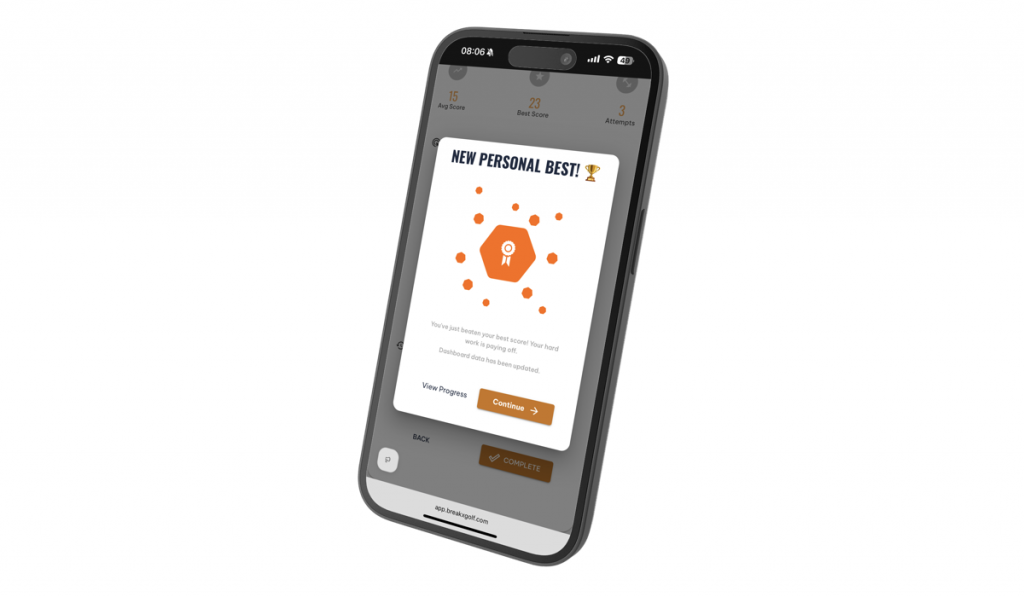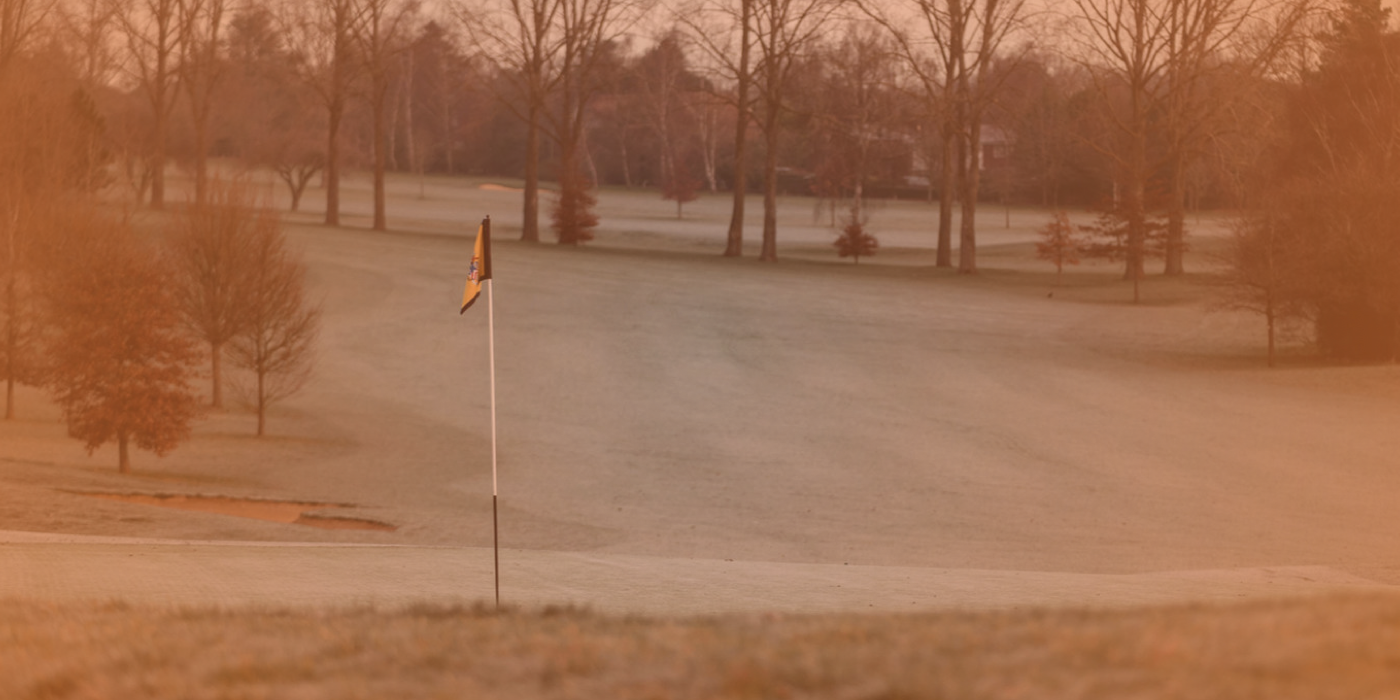If you’re serious about getting better at golf, the winter represents a great time to reflect, reset and prepare for an exceptional golfing season. In this article, we break down how to practice golf in the winter to truly make a difference to your handicap and scoring.
Here is a free tool to get you going, it’s a mini version of what the Break X Golf app does when you enter your playing stats.
Winter Golf Practice Goal Widget
How to Practice Golf Effectively in Winter:
- Set your winter goals
- Track playing stats to identify weak areas
- Analyse your data to prioritise practice focus
- Build a practice plan with specific goals
- Prioritise practice quality over practice volume
- Set up an effective indoor practice environment
- Track progress and refine plan
Set Your Goals
Decades of research have shown that setting goals helps you improve at a quicker rate. It also takes an abstract concept like getting better at golf, and turns it into a simple set of process goals. Such as improving your driving and approach play by ‘x’ amount of shots. This makes your journey simpler and far easier to track.
The first step is to set an outcome goal for how many shots you plan to improve by (start handicap vs handicap goal). Next is working out how you will improve your golf game by this value and to answer this question, you’ll need some playing stats (see below).
Track Your Playing Stats
Every golfer can tell you what their strengths and weaknesses are as a player. They can talk for an hour about what is holding them back. However, without playing stats, you will never truly know how many shots each area of your game is costing you.
If you are going to spend 2+ hours practising each week, please spend 5 minutes entering your playing stats so you know you are working on the right areas. This is one of the biggest areas holding most golfers back.
What stats should you track?
The gold standard for tracking your golf performance is Strokes Gained analysis – the same system used by PGA Tour professionals. This breaks down your game into four key areas (driving, approach, short game, putting) and shows exactly where you’re losing shots compared to a benchmark group of golfers.
However, if you have a handicap above 18, basic stats will be a great place to start (think fairways and greens hit in regulation, putts per round…). Another simple but really useful set of metrics are checking how many birdies, pars, bogeys and double bogeys or worse you make each round and calculating your average score on par 3s, 4s & 5s. This data gives you a surprisingly good insight into how to lower your scores.
Break X Golf members gain access to our free beta Strokes Gained tracking app, which collects all the above and more, making it simple to track this data during or after your rounds.

How many rounds to analyse?
Three to five rounds of data is ideal, but even one round of golf is very valuable. Golfers often get caught up on how many rounds to look at, but the reality is you’ll get the same answers about your golf game when you look at 3, 5, 10 or 25 rounds of data.
The key is to base your practice on what the data tells you and take action.
Analyse Your Data to Prioritise Practice Focus
Once you have your data, the next step is to work out what is holding you back. This is the core of the Break X Golf app, so apologies, but we can’t give all of our secrets away.
However, you should look at your data and check averages for your target handicap, then try to close the gap.
The biggest mistake in golf practice is working on everything at once. Your winter practice should focus heavily on your 1-2 weakest areas – this is where you’ll see the fastest handicap improvement.
For example, if putting is your weakness (losing 2.5 shots per round), spend 60% of your winter practice time on putting fundamentals, start line, pace control and green reading. Don’t waste time perfecting an already-solid driver swing. Just keep these areas ticking along.
Action step: use our tool above to rank your four game areas (driving, approach, short game, putting) from weakest to strongest. Allocate practice time proportionally, with your weakest area getting the most attention.
Build a Practice Plan with Specific Goals
Random practice doesn’t create lasting improvement. Elite golfers follow structured practice plans with a focus on the specific areas holding you back.
Your winter practice plan should include:
- Technical work: Work with your coach and use ball flight data to improve your technique in the areas of focus.
- Skill development games: Play focused drills that make practice more realistic, challenging and measurable
- Performance benchmarks: Track your progress in these skills games over time.
This is the second core focus of the Break X Golf app. You enter your stats and the app ranks the areas of your game and builds you a personalised plan based on your playing stats and how much time you have to practice.
We regularly get feedback that we have the best set of skill development games on the market, from golfers who have tried every practice solution. Here is a little taster of a skill development game for your driving practice. This game is specifically focused on golfers who miss more fairways to the right.
Playing these games each week and seeing if you can beat your best scores directly translates into your ability to shoot lower scores on the golf course.
Break X Golf provides over 130 skill-building games that turn boring practice into engaging challenges. Each drill has clear scoring systems and progression levels, so you always know if you’re improving.
Prioritise Quality Over Practice Volume
Hitting 100 balls without focus won’t improve your golf game. Effective practice needs to be specific, suitably challenging and have clear feedback. I lectured in Motor Learning for 10 years at university, and this is what it boils down to.
At the time of writing this article, we’ve just run a data study looking at what factors were most related to golfers who lowered their handicap in the app. There is no surprise that the number of practice activities completed each week in the app is the best predictor of success.
Golfers who completed 2.5 activities per week were more than twice as likely to lower their handicap, compared to golfers who completed less than 1.5 activities per week. However, above 2.5 practice activities per week, the handicap improvements quickly tailed off.
What does this mean for you?
One to two hours of highly focused practice on key areas is the most important factor. More practice is better, but diminishing returns set in pretty quickly for most golfers.
Note: As you get towards scratch and beyond, these figures do change, and you need a higher volume of practice to keep improving.
Set Up an Effective Indoor Practice Environment
If you are living in Southern California, you can probably skip this section. However, for many golfers, the nights draw in, golf courses become very wet or even close and effective practice becomes more challenging.
Try to find simple ways to practice the core areas of your game. A putting mat at home that gives you clear feedback on aim and start line will keep your putting mechanics in much better order than a carpet with no markings. You can also keep your chipping sharp by practising to your putting mat from a section of carpet.
Having access to a golf simulator allows you to keep track of strike, swing path, and club face angle during technical practice, but it also makes playing skills games for driving and approach play much more fun. If you can find a local simulator and plan out time for technical practice and skills games, you’ll be able to come out of a cold winter with some serious improvements.
Track Your Progress
Without playing golf, you are unlikely to see your handicap reduce. However, if you can start to see new personal bests in skills games you will know you are on the right path to improving key areas of your game and shooting lower scores.
This helps to track your progress and keeps you motivated. Good news, the Break X Golf app tracks all of your practice scores, reminds you of PB’s and unlocks more challenging practice games as you improve.

Summary
This isn’t the sexiest answer to how to get better at golf during the winter, but after 20 years of coaching and trying to improve my own game, this is the most effective approach to actually shooting lower scores.
I hope this article has given you a useful framework to go away and work out how to practice this winter. If you want help with any of this process, feel free to sign up for a 7-day free trial with the Break X Golf app, and just get in touch if you would like access to the beta playing stats app.
Happy golfing – Will @ Break X Golf
